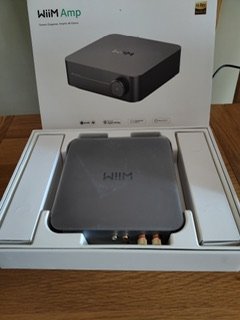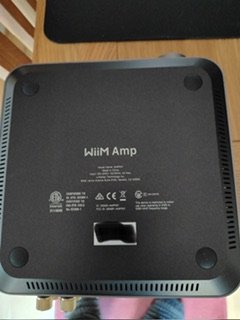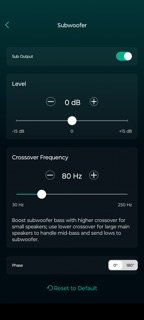Brantome
Moderator
Guess it's a little bit overdue due to personal circumstances and real life getting in the way, but here's my experience with the WiiM Amp over the 2 to 3 weeks I’ve had it. I appreciate it isn’t a review as such (those more experienced in these matters already have had their say) but hopefully it’ll still be of interest to those thinking of buying the Amp.
Unboxing
As I posted on first receiving it, the WiiM Amp comes across as a substantial and somewhat classy looking item from the packaging (37x26x8cm) thru to the unit itself. As Darko said in his first look blog, "If you’ve unboxed a Macbook or Macbook Pro, you’ve already unboxed the WiiM Amp. The WiiM’s box dimensions, material structure, graphic design and slow-release lid are all extremely similar to Apple’s”.



As well as the unit itself, you get a remote (the same as used for the other WiiM devices) and the expected power, RCA and HDMI cables which again appear to be of a better quality than previously.
Some of the initial challenges I faced in trying out the Amp were nothing to do with the Amp itself – despite having used hi fi gear for half a century or more, I only really have a single main music system, my oft mentioned Linn MDSM/4 and 4 ohm M109 speakers (see https://www.stereophile.com/content/linn-majik-109-loudspeaker-specifications).
I do have a second small Denon Piccolo system in my summerhouse, so I intended to use its SC-N4 6 ohm speakers (see https://www.hyperfi.co.uk/speakers/denon-sc-n4-ceol-piccolo-bookshelf-speakers-scn4-white) to connect to the Amp.
However, despite having three large boxes of interconnect cables collected over the years (which hi fi user doesn’t have such boxes?), I unbelievably didn’t have any speaker cable or banana plugs, so had to order those and wait a few days for them to arrive.
I found these banana/BFA plugs (https://www.amazon.co.uk/dp/B0B6398YX1) were a good fit for the WiiM Amp (thanks again @onlyoneme), and ordered a few metres of KabelDirekt 2x2.5mm² Pure Copper Stereo Audio Speaker Wire & Cable (https://www.amazon.co.uk/gp/product/B098NS8FD3).
Setup & Use
Once I had all the pieces in place, the WiiM Amp was the same as the Mini/Pro/Pro Plus in being very easy to setup from the WiiM Home app: it connected to Wi-Fi straight away then checked for latest firmware version.
There’s no real difference in WiiM Home app for the Amp other than a subwoofer entry under Audio Settings, apart from the omission of an Audio Outputs section that I’ve reported to WiiM. Without that, there doesn’t appear to be a way to select Bluetooth output nor Airplay casting that are mentioned in the WiiM Amp user guide. That also means you can’t choose whatever digital filters the Amp’s DAC may have. I’m sure this is a temporary bug in the app/firmware that will be resolved in short order.
That apart, all the features we have in the Pro and Pro Plus are there for the Amp, so it’s a piece of cake to get it up and running. The Squeezelite client is also available straight out of the box.
Using a TAPO P110 monitoring smart plug, the Amp appears to draw around 15w when playing at half volume which is loud enough for normal listening (and maybe a little overloud at 65-70db (spl) according to my phone sound meter app) in my surroundings and with the speakers I’m using. That drops to 6w in standby/off. The Amp unfortunately doesn’t have a physical on/off switch which I’d prefer on a mains unit given where I need to plug it in.
Like all things, how the Amp sounds is very dependent on the speakers you use with it, your room acoustics, preferences and hearing and so on. I've been using the Amp off and on in a relatively small room with the aforementioned Denon speakers as well as in a slightly larger room with my much better Linn M109 speakers. I find it eminently listenable in both setups, but of course more so with the better speakers. My sonic vocabulary doesn't extend much beyond that but I can say it does have a slightly glassier, more brittle sound at higher volumes compared to my usual amp which cost ten times as much, so there’s maybe no surprise there.
USB connected media
I first tried a SanDisk Cruzer Fit 32GB USB 2.0 Flash Drive with a dozen or so albums copied across to it and it immediately appeared as a Media Server called WiiM Amp-F80C:Media Server under the Home Music Share option in the WiiM Home app.
Things didn’t go so well with my 4TB external Seagate HDD – the Amp doesn’t supply enough amperage so the disc just was just clicking off and on. I had to use a Y connector cable connected to a USB power outlet to get drive operational. It took a long time to discover all music tracks on the drive as it was a backup of my entire music, photos and documents – it was probably a bad first choice to try.
I then purchased a "SanDisk 1TB Extreme Portable SSD, USB-C USB 3.2 Gen 2, External NVMe Solid State Drive" and copied some files across, but the Amp failed to recognise it. So I reformatted it from exFat to NTFS and tried again to no avail (the Amp supports either filesystem – not sure which others though). Turns out that it needs around 1.2A to drive it, but as the Amp USB slot is only rated for 0.63A as measured by @onlyoneme, I had to order another USB Y cable to power it externally. When that arrived a few days later, I was able to copy just my music files to it - around 20k tracks, mixed FLAC and MP3.
It still took the Amp a little while to index all the entries: I had intended to time it but was diverted and I'd guess it took at least half an hour even with that fast SSD. I don't know if the WiiM Amp processes all this or whether the WiiM app on an arguably more powerful phone is in anyway involved. I suspect it’s just the Amp itself.
Also, the indexing generated multiple entries after power down/up during initial tests but that perhaps has been already been resolved by newer firmware.
The resulting music library appears under Home Music Share like any other UPNP/DLNA server - indeed it looks like off the shelf UPNP server code with menu entries for Browse Folders, Music, Pictures and Video, with Music leading to Album, All Music, Artist, Folders, Genre, Playlists and Recently Added, the last of which doesn’t appear to show anything.



The Amp creates a wiim_cache folder on the drive containing a files.db file which I guess is the index, plus an art_cache folder which replicates your music folder(s) hierarchy with a jpeg entry for every track in those folders, which leads to a high degree of duplication. In my case for roughly 20k tracks, those files and database take up 1.2GB on my USB drive.
There are no configuration options for this UPNP server - it's a fairly simple structure but probably sufficient for most casual users.
After indexing, the UPNP server is responsive and performs well in use.
I'd say the use of the USB port to access music files is probably mainly for casual or adhoc use, or for those with a relatively small library, as I'd guess those with a larger library would already have it set up on a NAS with the server software of their choice such as MinimServer, AssetUPNP or alternatives like LMS, Plex etc.
Subwoofer
I don’t normally use a subwoofer as I'm not a fan of subs for stereo music listening so had to press my Echo Studio into use and the results weren't good as might be expected with a proper subwoofer - but that's nothing to do with the WiiM Amp. For the use of a subwoofer, you’d be better consulting other users.
However, trying that gave me the chance at least to view the Subwoofer option in the amp and try the sliders. See the attached screenshot

The crossover frequency also acts as a high pass filter with the low frequencies going to the subwoofer, and only the higher frequencies going to the speakers as already been answered both in Darko’s article and here in the forum by @onlyoneme.
HDMI arc in
I fed the output from my Samsung Frame TV from its HDMI eARC socket into the WiiM amp HDMI ARC (not eARC) connection and was able to use the Amp for audio output which it did well, but only after I had to make some changes to my TV’s audio output which is normally set for Dolby Digital as I normally use its eARC socket for my Fire TV Stick 4K Max/ Echo Studio in home theatre mode. After changing the TV sound to PCM, the Amp sprung into life. As per the Amp manual “The HDMI ARC and optical input port on the WiiM Amp are tailored for stereo PCM audio. It does not support other TV audio formats like Dolby Digital, Dolby Atmos, or DTS”, so if your Amp doesn’t play any TV sound when connected over ARC, check your TV’s sound settings.
When turned on, the TV did eventually appear to switch the Amp’s input to HDMI. I wouldn’t say it was instantaneous, maybe even as long as 20-30 seconds. As someone used to using the app to switch sources, that didn’t bother me. On turning off the TV, the Amp didn’t switch back its previous Wi-Fi input, which again I didn’t see as an issue.
The TV remote could be used to control the Amp volume, which I accidentally discovered when using the WiiM app to change to Wi-Fi rather than HDMI without first turning off the TV. I would say there should be a separate volume control for each input on the amp as the sound blared out when I switched to Wi-Fi after listening to the TV.
Verdict:
Overall, I think WiiM have another winner on its hands with the WiiM Amp. It certainly generates a great first impression due to the quality of the packaging and the design, look and feel of the product itself. It is very easy to set up, has same large range of features and supported services as its successful sibling products, and sounds very good when matched with even modestly price speakers. I can see it being a great starter or second system for a lot of people, and at its £299 price it's an absolute bargain.
Footnote:
I noted with interest in Darko’s article that he mentioned the “static” apparently killing the amp. I experienced similar and wondered whether I’d fried my test unit when I was swapping speakers (I had already used the remote’s power off button to turn it off). It took a fair bit of rebooting and sweat till I finally got it back up and running, eventually having to connect it over Ethernet as Wi-Fi wasn’t cutting it during re-setup. Hopefully WiiM can address this issue.
Unboxing
As I posted on first receiving it, the WiiM Amp comes across as a substantial and somewhat classy looking item from the packaging (37x26x8cm) thru to the unit itself. As Darko said in his first look blog, "If you’ve unboxed a Macbook or Macbook Pro, you’ve already unboxed the WiiM Amp. The WiiM’s box dimensions, material structure, graphic design and slow-release lid are all extremely similar to Apple’s”.



As well as the unit itself, you get a remote (the same as used for the other WiiM devices) and the expected power, RCA and HDMI cables which again appear to be of a better quality than previously.
Some of the initial challenges I faced in trying out the Amp were nothing to do with the Amp itself – despite having used hi fi gear for half a century or more, I only really have a single main music system, my oft mentioned Linn MDSM/4 and 4 ohm M109 speakers (see https://www.stereophile.com/content/linn-majik-109-loudspeaker-specifications).
I do have a second small Denon Piccolo system in my summerhouse, so I intended to use its SC-N4 6 ohm speakers (see https://www.hyperfi.co.uk/speakers/denon-sc-n4-ceol-piccolo-bookshelf-speakers-scn4-white) to connect to the Amp.
However, despite having three large boxes of interconnect cables collected over the years (which hi fi user doesn’t have such boxes?), I unbelievably didn’t have any speaker cable or banana plugs, so had to order those and wait a few days for them to arrive.
I found these banana/BFA plugs (https://www.amazon.co.uk/dp/B0B6398YX1) were a good fit for the WiiM Amp (thanks again @onlyoneme), and ordered a few metres of KabelDirekt 2x2.5mm² Pure Copper Stereo Audio Speaker Wire & Cable (https://www.amazon.co.uk/gp/product/B098NS8FD3).
Setup & Use
Once I had all the pieces in place, the WiiM Amp was the same as the Mini/Pro/Pro Plus in being very easy to setup from the WiiM Home app: it connected to Wi-Fi straight away then checked for latest firmware version.
There’s no real difference in WiiM Home app for the Amp other than a subwoofer entry under Audio Settings, apart from the omission of an Audio Outputs section that I’ve reported to WiiM. Without that, there doesn’t appear to be a way to select Bluetooth output nor Airplay casting that are mentioned in the WiiM Amp user guide. That also means you can’t choose whatever digital filters the Amp’s DAC may have. I’m sure this is a temporary bug in the app/firmware that will be resolved in short order.
That apart, all the features we have in the Pro and Pro Plus are there for the Amp, so it’s a piece of cake to get it up and running. The Squeezelite client is also available straight out of the box.
Using a TAPO P110 monitoring smart plug, the Amp appears to draw around 15w when playing at half volume which is loud enough for normal listening (and maybe a little overloud at 65-70db (spl) according to my phone sound meter app) in my surroundings and with the speakers I’m using. That drops to 6w in standby/off. The Amp unfortunately doesn’t have a physical on/off switch which I’d prefer on a mains unit given where I need to plug it in.
Like all things, how the Amp sounds is very dependent on the speakers you use with it, your room acoustics, preferences and hearing and so on. I've been using the Amp off and on in a relatively small room with the aforementioned Denon speakers as well as in a slightly larger room with my much better Linn M109 speakers. I find it eminently listenable in both setups, but of course more so with the better speakers. My sonic vocabulary doesn't extend much beyond that but I can say it does have a slightly glassier, more brittle sound at higher volumes compared to my usual amp which cost ten times as much, so there’s maybe no surprise there.
USB connected media
I first tried a SanDisk Cruzer Fit 32GB USB 2.0 Flash Drive with a dozen or so albums copied across to it and it immediately appeared as a Media Server called WiiM Amp-F80C:Media Server under the Home Music Share option in the WiiM Home app.
Things didn’t go so well with my 4TB external Seagate HDD – the Amp doesn’t supply enough amperage so the disc just was just clicking off and on. I had to use a Y connector cable connected to a USB power outlet to get drive operational. It took a long time to discover all music tracks on the drive as it was a backup of my entire music, photos and documents – it was probably a bad first choice to try.
I then purchased a "SanDisk 1TB Extreme Portable SSD, USB-C USB 3.2 Gen 2, External NVMe Solid State Drive" and copied some files across, but the Amp failed to recognise it. So I reformatted it from exFat to NTFS and tried again to no avail (the Amp supports either filesystem – not sure which others though). Turns out that it needs around 1.2A to drive it, but as the Amp USB slot is only rated for 0.63A as measured by @onlyoneme, I had to order another USB Y cable to power it externally. When that arrived a few days later, I was able to copy just my music files to it - around 20k tracks, mixed FLAC and MP3.
It still took the Amp a little while to index all the entries: I had intended to time it but was diverted and I'd guess it took at least half an hour even with that fast SSD. I don't know if the WiiM Amp processes all this or whether the WiiM app on an arguably more powerful phone is in anyway involved. I suspect it’s just the Amp itself.
Also, the indexing generated multiple entries after power down/up during initial tests but that perhaps has been already been resolved by newer firmware.
The resulting music library appears under Home Music Share like any other UPNP/DLNA server - indeed it looks like off the shelf UPNP server code with menu entries for Browse Folders, Music, Pictures and Video, with Music leading to Album, All Music, Artist, Folders, Genre, Playlists and Recently Added, the last of which doesn’t appear to show anything.



The Amp creates a wiim_cache folder on the drive containing a files.db file which I guess is the index, plus an art_cache folder which replicates your music folder(s) hierarchy with a jpeg entry for every track in those folders, which leads to a high degree of duplication. In my case for roughly 20k tracks, those files and database take up 1.2GB on my USB drive.
There are no configuration options for this UPNP server - it's a fairly simple structure but probably sufficient for most casual users.
After indexing, the UPNP server is responsive and performs well in use.
I'd say the use of the USB port to access music files is probably mainly for casual or adhoc use, or for those with a relatively small library, as I'd guess those with a larger library would already have it set up on a NAS with the server software of their choice such as MinimServer, AssetUPNP or alternatives like LMS, Plex etc.
Subwoofer
I don’t normally use a subwoofer as I'm not a fan of subs for stereo music listening so had to press my Echo Studio into use and the results weren't good as might be expected with a proper subwoofer - but that's nothing to do with the WiiM Amp. For the use of a subwoofer, you’d be better consulting other users.
However, trying that gave me the chance at least to view the Subwoofer option in the amp and try the sliders. See the attached screenshot

The crossover frequency also acts as a high pass filter with the low frequencies going to the subwoofer, and only the higher frequencies going to the speakers as already been answered both in Darko’s article and here in the forum by @onlyoneme.
HDMI arc in
I fed the output from my Samsung Frame TV from its HDMI eARC socket into the WiiM amp HDMI ARC (not eARC) connection and was able to use the Amp for audio output which it did well, but only after I had to make some changes to my TV’s audio output which is normally set for Dolby Digital as I normally use its eARC socket for my Fire TV Stick 4K Max/ Echo Studio in home theatre mode. After changing the TV sound to PCM, the Amp sprung into life. As per the Amp manual “The HDMI ARC and optical input port on the WiiM Amp are tailored for stereo PCM audio. It does not support other TV audio formats like Dolby Digital, Dolby Atmos, or DTS”, so if your Amp doesn’t play any TV sound when connected over ARC, check your TV’s sound settings.
When turned on, the TV did eventually appear to switch the Amp’s input to HDMI. I wouldn’t say it was instantaneous, maybe even as long as 20-30 seconds. As someone used to using the app to switch sources, that didn’t bother me. On turning off the TV, the Amp didn’t switch back its previous Wi-Fi input, which again I didn’t see as an issue.
The TV remote could be used to control the Amp volume, which I accidentally discovered when using the WiiM app to change to Wi-Fi rather than HDMI without first turning off the TV. I would say there should be a separate volume control for each input on the amp as the sound blared out when I switched to Wi-Fi after listening to the TV.
Verdict:
Overall, I think WiiM have another winner on its hands with the WiiM Amp. It certainly generates a great first impression due to the quality of the packaging and the design, look and feel of the product itself. It is very easy to set up, has same large range of features and supported services as its successful sibling products, and sounds very good when matched with even modestly price speakers. I can see it being a great starter or second system for a lot of people, and at its £299 price it's an absolute bargain.
Footnote:
I noted with interest in Darko’s article that he mentioned the “static” apparently killing the amp. I experienced similar and wondered whether I’d fried my test unit when I was swapping speakers (I had already used the remote’s power off button to turn it off). It took a fair bit of rebooting and sweat till I finally got it back up and running, eventually having to connect it over Ethernet as Wi-Fi wasn’t cutting it during re-setup. Hopefully WiiM can address this issue.
Last edited:

